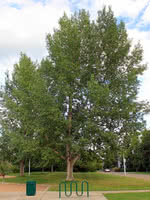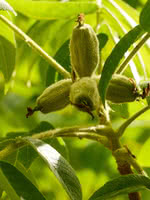Mon-Fri 9am - 5pm Mountain time
Assiniboine Poplar vs Butternut (White Walnut)
Populus x Assiniboine
Juglans cinerea
Assiniboine poplar is a tall, fast growing tree that has a shapely oval form and dense foliage. This hybrid poplar is a male clone and produces no fuzz or fluff. Assiniboine poplar can handle tough conditions such as: urban pollution, environmental salt, drought, poor soil, and even some standing water.
Butternut is one of the few walnut varieties native to Canada. The nuts are sought after for their mild, sweet, and oily taste. Ensure this tree is planted in full sun and well-drained soil for best results.
Butternut is self-fertile but it has better yields when planted near other butternuts. It can survive in zone 2, but reliably produces nuts in zone 3.
A top CO2 absorbing species. Experts think this tree may help climate change more than others.
Assiniboine Poplar Quick Facts
Butternut (White Walnut) Quick Facts
In row spacing: 2.4 - 3 m (8 - 10 ft)

